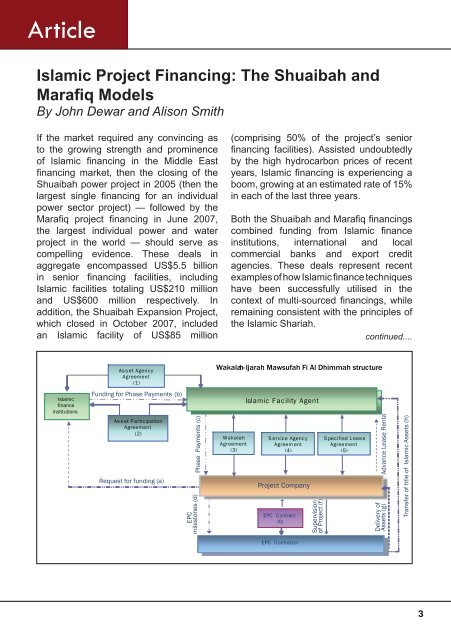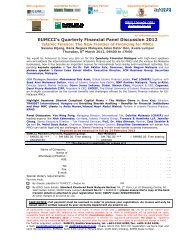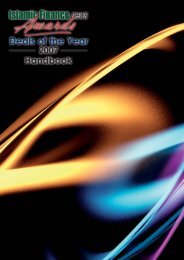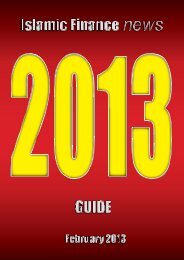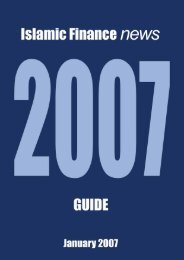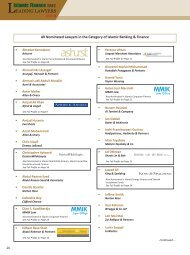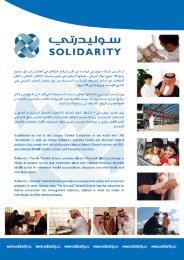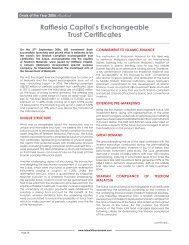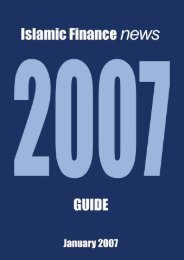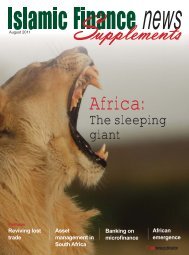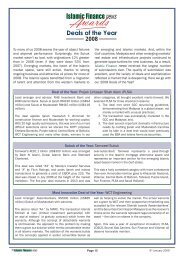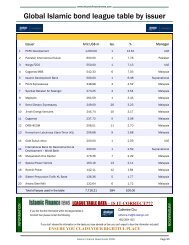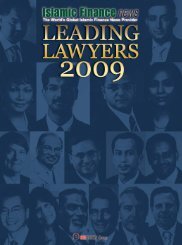Download the Full Issue - Islamic Finance News
Download the Full Issue - Islamic Finance News
Download the Full Issue - Islamic Finance News
Create successful ePaper yourself
Turn your PDF publications into a flip-book with our unique Google optimized e-Paper software.
Article<br />
<strong>Islamic</strong> Project Financing: The Shuaibah and<br />
Marafiq Models<br />
By John Dewar and Alison Smith<br />
If <strong>the</strong> market required any convincing as<br />
to <strong>the</strong> growing strength and prominence<br />
of <strong>Islamic</strong> fi nancing in <strong>the</strong> Middle East<br />
fi nancing market, <strong>the</strong>n <strong>the</strong> closing of <strong>the</strong><br />
Shuaibah power project in 2005 (<strong>the</strong>n <strong>the</strong><br />
largest single fi nancing for an individual<br />
power sector project) — followed by <strong>the</strong><br />
Marafi q project fi nancing in June 2007,<br />
<strong>the</strong> largest individual power and water<br />
project in <strong>the</strong> world — should serve as<br />
compelling evidence. These deals in<br />
aggregate encompassed US$5.5 billion<br />
in senior fi nancing facilities, including<br />
<strong>Islamic</strong> facilities totaling US$210 million<br />
and US$600 million respectively. In<br />
addition, <strong>the</strong> Shuaibah Expansion Project,<br />
which closed in October 2007, included<br />
an <strong>Islamic</strong> facility of US$85 million<br />
(comprising 50% of <strong>the</strong> project’s senior<br />
fi nancing facilities). Assisted undoubtedly<br />
by <strong>the</strong> high hydrocarbon prices of recent<br />
years, <strong>Islamic</strong> financing is experiencing a<br />
boom, growing at an estimated rate of 15%<br />
in each of <strong>the</strong> last three years.<br />
Both <strong>the</strong> Shuaibah and Marafiq fi nancings<br />
combined funding from <strong>Islamic</strong> finance<br />
institutions, international and local<br />
commercial banks and export credit<br />
agencies. These deals represent recent<br />
examples of how <strong>Islamic</strong> fi nance techniques<br />
have been successfully utilised in <strong>the</strong><br />
context of multi-sourced fi nancings, while<br />
remaining consistent with <strong>the</strong> principles of<br />
<strong>the</strong> <strong>Islamic</strong> Shariah.<br />
continued....<br />
Wakalah-Ijarah Mawsufah Fi Al Dhimmah structure<br />
<strong>Islamic</strong><br />
finance<br />
institutions<br />
Asset Agency<br />
Agreement<br />
(1)<br />
Funding for Phase Payments (b)<br />
Asset Participation<br />
Agreement<br />
(2)<br />
Request for funding (a)<br />
Phase Payments (c)<br />
EPC<br />
milestones (d)<br />
Wakalah<br />
Agreement<br />
(3)<br />
<strong>Islamic</strong> Facility Agent<br />
Service Agency<br />
Agreem ent<br />
(4)<br />
Project Company<br />
EPC Contract<br />
(6)<br />
Supervision<br />
of Project (f)<br />
S pecified Lease<br />
Agreement<br />
(5)<br />
Advance Lease Renta<br />
Delivery of<br />
Assets (g)<br />
Transfer of title of <strong>Islamic</strong> Assets (h)<br />
EPC Contractor<br />
3


